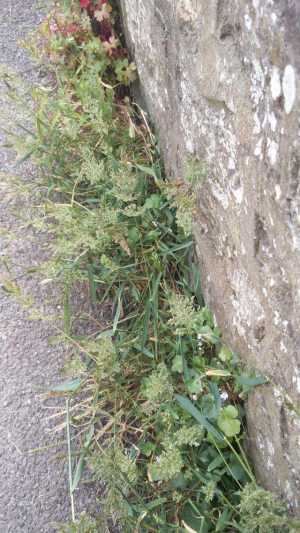Polypogon viridis

Observation - Polypogon viridis - UK and Ireland. Description: Since Bristol City Council stopped the use of glyphosate to clear gutters and pavements plants have
Since Bristol City Council stopped the use of glyphosate to clear gutters and pavements plants have taken the opportunity.
This grass, whose flowering panicles caught my eye, is doing well.
Grasses are not easy… but worth a try I thought.
The length of the culm ( flowering stem) is 50cm.
.
Using the FSC A Lateral Key to Common Grasses’ I chose:
Flower-heads like a tree, with spikelets arranged singly or in clusters at the ends of long branches which may be spreading or upright.
Spikelet contains only one or two fertile florets, which are equalled or exceeded in length by one of both glumes and often completely hidden by them.
Awns absent (though glumes and lemmas may be pointed)
Spikelets 2-6mm long
Ligule of lower stem leaves at least as long as half its width, acute or obtuse, sometimes tattered.
Leaf blades and sheaths completely hairless to the naked eye.
Plant spreading by leafy overground stolons, from which shoots arise singly or in small clusters.
This led me to Agrostis stolonifera. The associated picture in the FSC leaflet seemed similar but.. this leaflet has only 30 of BI grasses (Poaceae).*
.
However, I thought I’d check it out in Stace (2021).
The key to Agrostis says “A difficult genus due to plasticity and genetic variation, hybridisation and over-use in the past of unreliable characters; just our cup of tea as we like a challenge on iSpot.
With palea and lemma same size …
Couplet 6 “anthers 0.2 -0.6mm.
Couplet 7 asks about a lemma awns (there are none) which leads to A. lachnantha. This is a rare wool alien, with very few records in BSBI Atlas 2022.
Stace mentions 15 alien species and list 7 Agrostis hybrids.
There are also two hybrids of Agrostis x Polypogon. A. stolonifera x P. viridis and A .stolonifera x P. monspeliensis. Neither has enough supporting characters for me to be happy with.
So I returned the full Poaceae key in Stace.
The penultimate couplet, Key F, “glumes with short pricklets or at least rough all over back; palea nearly as long as lemma; lemma ½ length of glumes.”
.
So, back to the m’scope for another photo.
.
Stace has three Polypogon species; the first couplet “both glumes and lemma unawned; spikelets disarticulating near base of pedicels“ = Polypogon viridis. “Neophyte-naturalised; roadsides and rough ground and by pools in Guernsey and Jersey. Scattered casual in Britain on tips and wasteland but now spreading rapidly and becoming naturalised in S & C England.”
.
The BSBI atlas 2022 shows this https://plantatlas2020.org/atlas/2cd4p9h.eee
The GBIF link shows many images from pavement/base of wall locations. https://www.gbif.org/species/5289919
I checked Flora Europaea and it gives anther size as 0.5-0.7mm.
.
I’m happy with this ID.
Comments welcome.
.
* for example, Grasses of the British Isles ( BSBI Handbook 13, 2009) contains descriptions of 67 genera and 220 species.
This grass, whose flowering panicles caught my eye, is doing well.
Grasses are not easy… but worth a try I thought.
The length of the culm ( flowering stem) is 50cm.
.
Using the FSC A Lateral Key to Common Grasses’ I chose:
Flower-heads like a tree, with spikelets arranged singly or in clusters at the ends of long branches which may be spreading or upright.
Spikelet contains only one or two fertile florets, which are equalled or exceeded in length by one of both glumes and often completely hidden by them.
Awns absent (though glumes and lemmas may be pointed)
Spikelets 2-6mm long
Ligule of lower stem leaves at least as long as half its width, acute or obtuse, sometimes tattered.
Leaf blades and sheaths completely hairless to the naked eye.
Plant spreading by leafy overground stolons, from which shoots arise singly or in small clusters.
This led me to Agrostis stolonifera. The associated picture in the FSC leaflet seemed similar but.. this leaflet has only 30 of BI grasses (Poaceae).*
.
However, I thought I’d check it out in Stace (2021).
The key to Agrostis says “A difficult genus due to plasticity and genetic variation, hybridisation and over-use in the past of unreliable characters; just our cup of tea as we like a challenge on iSpot.
With palea and lemma same size …
Couplet 6 “anthers 0.2 -0.6mm.
Couplet 7 asks about a lemma awns (there are none) which leads to A. lachnantha. This is a rare wool alien, with very few records in BSBI Atlas 2022.
Stace mentions 15 alien species and list 7 Agrostis hybrids.
There are also two hybrids of Agrostis x Polypogon. A. stolonifera x P. viridis and A .stolonifera x P. monspeliensis. Neither has enough supporting characters for me to be happy with.
So I returned the full Poaceae key in Stace.
The penultimate couplet, Key F, “glumes with short pricklets or at least rough all over back; palea nearly as long as lemma; lemma ½ length of glumes.”
.
So, back to the m’scope for another photo.
.
Stace has three Polypogon species; the first couplet “both glumes and lemma unawned; spikelets disarticulating near base of pedicels“ = Polypogon viridis. “Neophyte-naturalised; roadsides and rough ground and by pools in Guernsey and Jersey. Scattered casual in Britain on tips and wasteland but now spreading rapidly and becoming naturalised in S & C England.”
.
The BSBI atlas 2022 shows this https://plantatlas2020.org/atlas/2cd4p9h.eee
The GBIF link shows many images from pavement/base of wall locations. https://www.gbif.org/species/5289919
I checked Flora Europaea and it gives anther size as 0.5-0.7mm.
.
I’m happy with this ID.
Comments welcome.
.
* for example, Grasses of the British Isles ( BSBI Handbook 13, 2009) contains descriptions of 67 genera and 220 species.